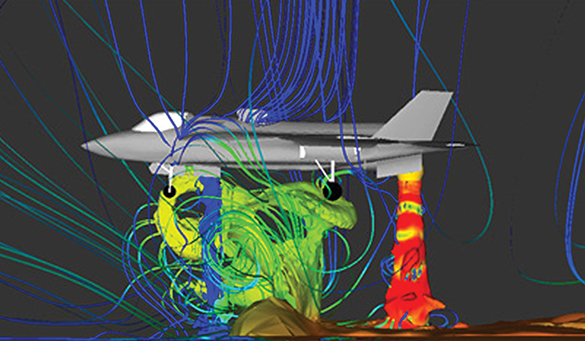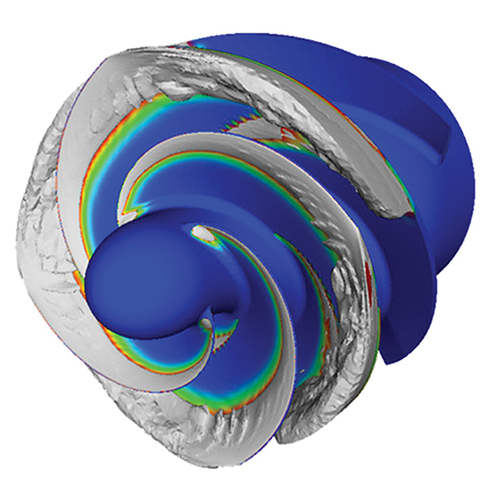
Modeling Tools Predict Flow in Fluid Dynamics
Originating Technology/NASA Contribution
Knowing what will happen before it happens is no easy task. That is why new spacecraft and technology are constantly being tested and refined—including the J-2X engine, which may power the upper stage of future NASA rockets. Data from tests like these help to ensure that the next generation of space explorers will travel safely into orbit.
Fueled by liquid oxygen and liquid hydrogen, the J-2X is a combination of the J-2 engine that propelled the Apollo-era rockets to the Moon, and the J-2S, a simplified version of the J-2 developed and tested toward the end of the Apollo Program.
The heart of this engine—the turbopump—is a complex piece of machinery that receives fuel from the storage tanks and then supplies it to the combustion chamber at the required flow, mixture, and pressure. Once the propellants mix and burn, they produce hot, pressurized exhaust gas that passes through a nozzle to accelerate the flow. This produces thrust that powers the rocket to move at approximately four times the speed of sound.
Because rocket engines like the J-2X operate under such extreme temperature and pressure, they present a unique challenge to designers who must test and simulate the technology. To model the physical and chemical phenomena that occur in these conditions, NASA engineers needed an advanced computer application with extremely complex and specialized capabilities.
Partnership
CRAFT Tech Inc., of Pipersville, Pennsylvania, specializes in computer programs for the simulation of complex fluid dynamics and combustion problems. In 2001, CRAFT Tech (an acronym for Combustion Research and Flow Technology) won the first of several Small Business Innovation Research (SBIR) contracts from Marshall Space Flight Center to develop software to simulate cryogenic fluid flows and related phenomena such as cavitation (bubbles that can lead to damage) in liquid rocket turbopumps.
According to Ashvin Hosangadi, principal scientist at CRAFT Tech, “There were a limited number of tools available to look at this problem at the time, but cavitation is very important to model, because it can cause major engine problems. For the first time, we were able to model the unsteady effects of cavitation in the low-pressure fuel pump of the space shuttle main engine (SSME),” says Hosangadi.
Through the SBIR program, CRAFT Tech enhanced its existing CRUNCH CFD (computational fluid dynamics) software and incorporated an advanced capability to predict the effects of cavitation in cryogenic fluids. This proved to be a significant improvement over the existing technology, which was limited to predicting turbopump performance in water.
By 2003, Stennis Space Center awarded CRAFT Tech additional SBIRs to extend the software’s capabilities. To date, CRAFT Tech has established a solid foundation of state-of-the-art tools that have impacted the design and operation of rocket engine test facilities such as NASA’s A-3 test stand for the J-2X and the B-2 test stand for the RS-68 five-engine cluster, as well as liquid propulsion for the J-2X and SSME.
“At Stennis, CRUNCH CFD provides a tool for designing reliable propulsion systems like the J-2X. By modeling rocket engine exhaust, or plumes, the software helps ensure those plumes will not cause damage to the facility, structure, or to the test article itself,” says Dr. Daniel Allgood, aerospace engineer at Stennis.
Product Outcome
CRUNCH CFD can simulate the physical and chemical phenomena in various liquid propulsion components and systems including cavitating flows, supercritical flows at high pressures, gas and liquid mixtures at critical pressures, cryogenic and non-cryogenic liquid flows, and fluid combustion at high pressures.
The primary market for CRUNCH CFD is the commercial aerospace industry, but both government and industry clients use the software for analyzing existing systems as well as designing new ones. Northrop Grumman and Boeing use the program for cryogenic pump work, combustion problems, and modeling engine noise reduction.
CRUNCH CFD is most unique due to its advanced capability for predicting phenomena that happen with cryogenic liquids and in high-pressure systems. Hosangadi explains, “Liquid rocket systems work with cryogenic systems that operate at very high pressures. These can’t be represented by simple equations used in other systems. Our specialty is to do simulations when representing the thermodynamics and physics becomes very difficult.”
Like liquid rocket turbopumps, industrial commercial pumps also demand advanced modeling capabilities, including simulations under extreme pressure and temperatures. Using CRUNCH CFD, one of the largest pump companies in the United States has significantly improved the performance of its newer products. Today, the NASA-derived technology is being used with a range of large, high-energy pumps including boiler feed pumps in the utilities industries and oil pumps in the petrochemical industry.
A long list of potential applications exists, including a range of fluid flow devices such as valves and thermal heat exchangers. In particular, the liquefied natural gas industry is an ideal application for CRUNCH CFD. Supertankers that transport the cryogenic fluid are similar to liquid rocket cryogenic tanks, but on a bigger scale. One of the common problems is sloshing of the liquid, which can lead to system instability and safety concerns.
In addition to analysis, CRAFT Tech provides licensing of CRUNCH CFD for complex physics and thermochemistry applications, as well as performs fundamental research in CFD, grid adaptation, aeroacoustics, turbulence, combustion, and multiphase flow. The company, however, credits NASA for a large portion of its success. “The work on cavitation led to CRUNCH CFD being used in the commercial industry, thanks to the NASA SBIR program. All of our commercial revenue is very much a function of the work from SBIRs,” says Hosangadi.
CRUNCH CFD® is a registered trademark of CRAFT Tech Inc.

CRAFT Tech software created this visual representation of the ground effects on the exhaust from an aircraft. Specializing in fluid dynamics, combustion, and aero-acoustics modeling for aerospace and commercial applications, CRAFT Tech provides commercial tools, consulting support, system design and concept evaluation, and ground and flight test support.

CRUNCH CFD software created this image of cavitation simulation of a cryogenic inducer, an important component of liquid rocket turbopumps.

Rockets of the future may be based on the Aries I-X, shown here at Kennedy Space Center in 2009. When developing the propulsion systems for future rockets, NASA uses a computer program from CRAFT Tech Inc.













